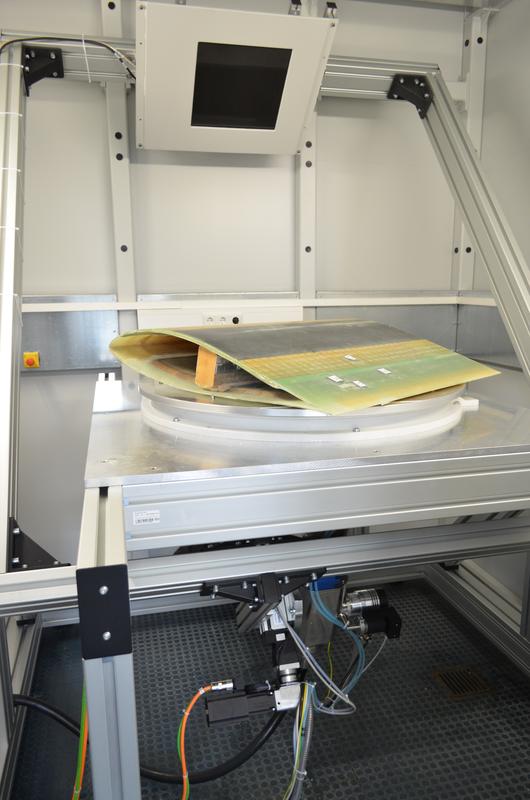Production-integrated inspection of large-scale CFRP components

CLARA<sup>®</sup>: Computer Laminography and radiography system Fraunhofer IZFP
In lightweight construction or in aviation application of fiber-reinforced plastics (FRP) is steadily rising. FRP components are often used in form of very large or flat shapes, which can be examined using the Fraunhofer IZFP’s CL device CLARA® (Computer Laminography and radiography system). As nondestructive inspection of complex components and materials is increasingly required along the entire material cycle but especially during the production process, the development of new, time-saving and cost-effective testing methods is essential.
CT as a widespread X-ray method can obtain high-resolution 3D volume images to depict the finest structures and details. But considering in particular objects, where CT is unsuitable, CL is an efficient and effective alternative. “While in medicine CL is widely used, industrial applications are seldom to found despite some outstanding advantages compared to CT”, Dr. Michael Maisl explains, senior scientist and group manager of the “Reconstruction, Image Processing, CT/CL by X-ray” group at Fraunhofer IZFP.
Unlike CT, CL is perfectly suited for high-resolution inspection of large or planar components. Compared to CT, the inspection time can be significantly reduced. Additionally, a variety of different recording shapes is available, which also enable adjustments to perform fully automated batch inspection.
Similar to CT, radiographs are taken from different angles to compute a three-dimensional representation of the object’s internal structure using a reconstruction algorithm.
Unlike CT, however, the rotation axis is not orthogonal, but inclined to the beam direction. “By this inclination the otherwise inevitable collision between the object and the source or the detector can be avoided. The arrangement ensures the penetration of the object covering any necessary irradiation angles. As a consequence the individual section planes can be reconstructed at any relevant resolution and represented adequately, “Maisl adds.
Traditionally, CL is used for the examination of electronic circuit boards. Recent application areas are related to modern lightweight materials such as fiber reinforced plastics (CFRP, GFRP), which are increasingly common, also in the form oversized parts for wind turbines or in automobile industry and in aviation. Further applications concern the defect inspection of parts or components, e.g. the detection of porosities or inclusions in car body parts or the detection of micro-cracks in photovoltaic modules.
Media Contact
All latest news from the category: Trade Fair News
Newest articles

You are What You Eat—Stanford Study Links Fiber to Anti-Cancer Gene Modulation
The Fiber Gap: A Growing Concern in American Diets Fiber is well known to be an important part of a healthy diet, yet less than 10% of Americans eat the minimum recommended…

Trust Your Gut—RNA-Protein Discovery for Better Immunity
HIRI researchers uncover control mechanisms of polysaccharide utilization in Bacteroides thetaiotaomicron. Researchers at the Helmholtz Institute for RNA-based Infection Research (HIRI) and the Julius-Maximilians-Universität (JMU) in Würzburg have identified a…

ASXL1 Mutation: The Hidden Trigger Behind Blood Cancers and Inflammation
Scientists show how a mutated gene harms red and white blood cells. LA JOLLA, CA—Scientists at La Jolla Institute for Immunology (LJI) have discovered how a mutated gene kicks off…



